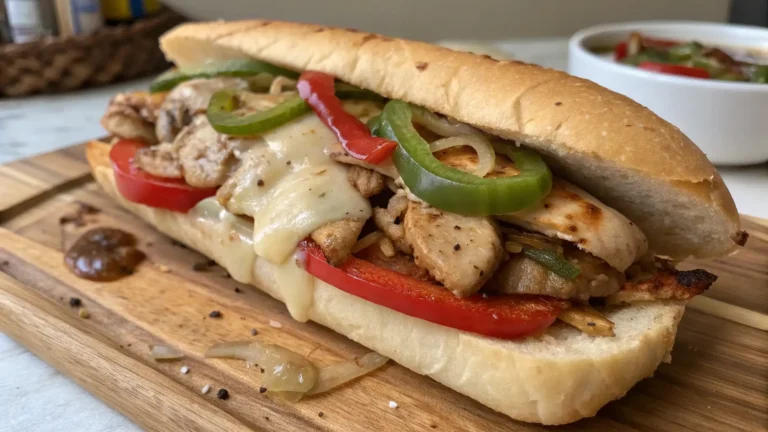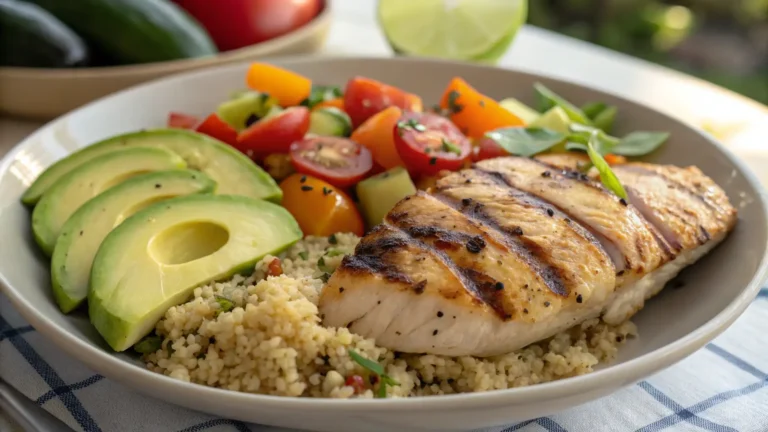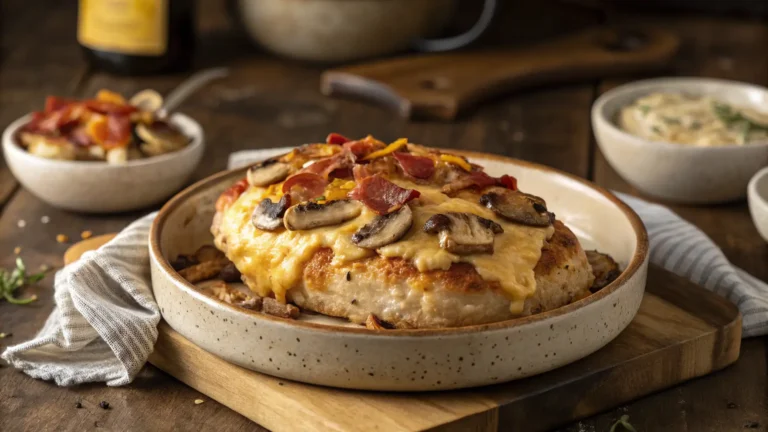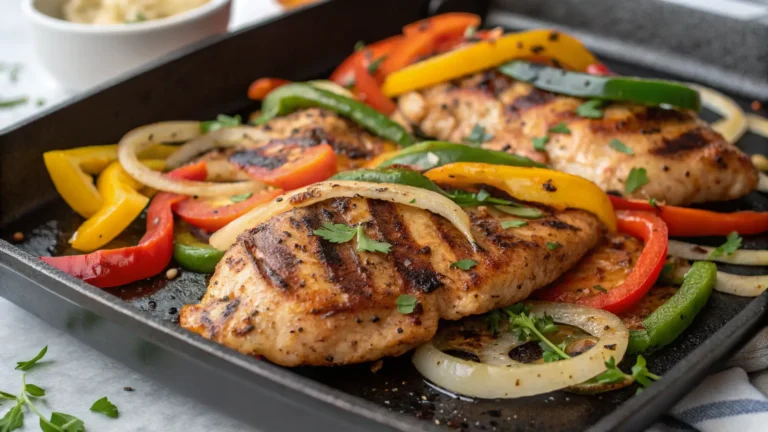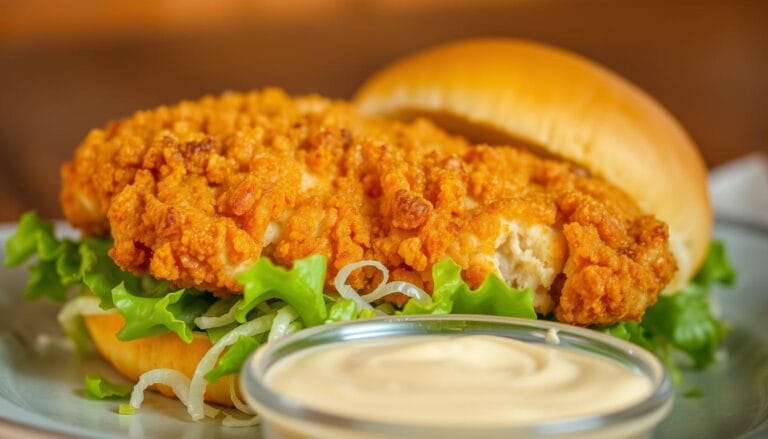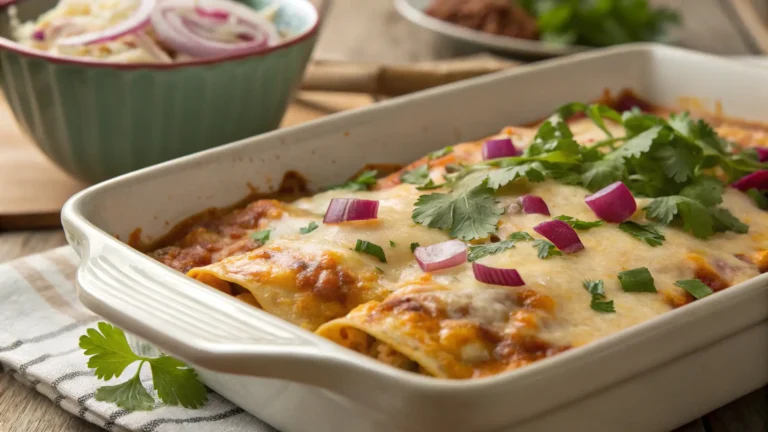Chicken Alfredo Recipe: The Creamiest & Easiest Homemade Guide
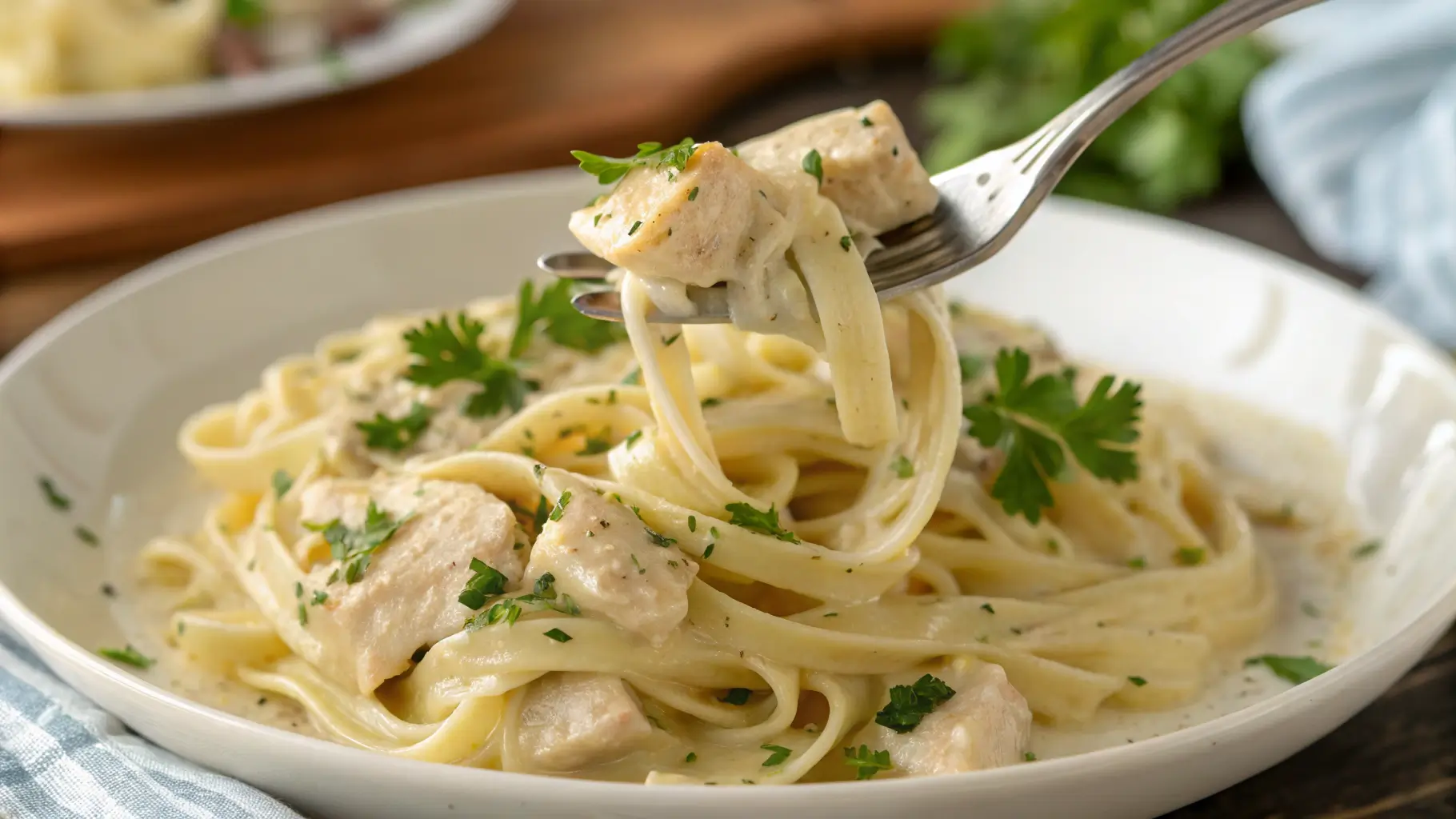
Table of Contents
Creamy, comforting, and rich in flavor, the chicken alfredo recipe is a favorite among pasta lovers in the U.S. and beyond. Whether you’re cooking a weeknight dinner or prepping a special meal for guests, this dish never fails to impress. It combines juicy seared chicken, velvety homemade alfredo sauce, and perfectly cooked pasta into a plate of pure satisfaction.
In this comprehensive guide, you’ll uncover exactly how to make a restaurant-quality chicken alfredo recipe right at home. From choosing the right ingredients to mastering the sauce and learning how to avoid common mistakes, we’ve covered every step in detail. You’ll even find suggestions for the best add-ons, sides, and creative ways to plate it beautifully. Looking for inspiration? Try our Tender Slow Cooker Cube Steak Recipe for another creamy comfort food favorite.
Let’s jump right into how to make the perfect chicken alfredo from scratch.
Introduction to the Perfect Chicken Alfredo Recipe
What Makes Chicken Alfredo So Popular?
The universal appeal of chicken alfredo lies in its creamy texture and savory balance. It’s both indulgent and familiar—a nostalgic meal that satisfies. Combining protein-rich chicken with a luxurious cheese-based sauce creates a filling yet sophisticated comfort food.
Alfredo sauce, which originated in Rome, evolved in the American kitchen by adding cream and butter to intensify richness. With time, this adaptation became a household staple, adored for its decadent consistency and minimal prep. It’s no wonder chicken alfredo remains a best-seller in restaurants and a go-to dinner choice for home cooks.
Why This Chicken Alfredo Recipe Stands Out
There are hundreds of chicken alfredo recipes floating around—but ours stands out for a few key reasons:
- Simplicity meets flavor: You’ll use real, fresh ingredients without complex steps.
- Perfect texture: Both the sauce and the chicken are prepared for max creaminess and tenderness.
- Customization options: Whether you want to go light with zoodles or heavy with extra cheese, we’ve got options.
Plus, this version is designed for success, even if you’re a beginner cook. From marination tricks to sauce-saving hacks, every section is geared toward making this the best chicken alfredo recipe you’ve ever made.
Want more rich flavors like this? Check out our Best Smoked Fish Brine Recipe for a seafood-based experience full of depth and balance.
Ingredients for Chicken Alfredo Recipe
Essential Ingredients You’ll Need
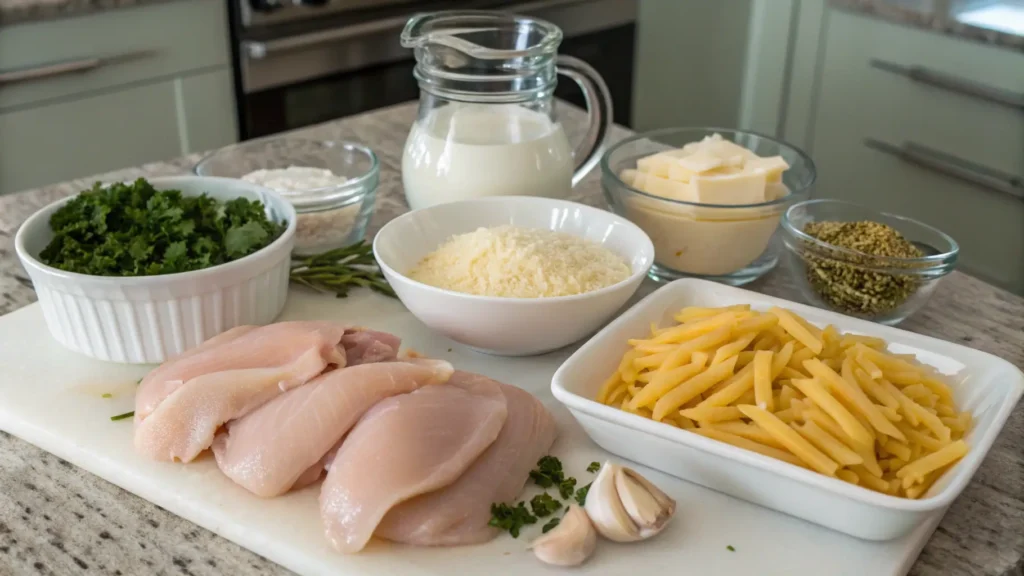
A stellar chicken alfredo recipe starts with quality ingredients. Here’s a complete list of what you’ll need to create a creamy, flavorful dish that rivals any restaurant version:
| Ingredient | Purpose |
|---|---|
| Boneless, skinless chicken breasts | Main protein |
| Fettuccine pasta | Traditional alfredo pairing |
| Heavy cream | Base for the rich sauce |
| Unsalted butter | Adds silkiness and flavor |
| Fresh garlic | For depth and aroma |
| Grated Parmesan cheese | The heart of alfredo sauce |
| Salt and pepper | Basic seasoning |
| Olive oil | To sauté the chicken |
| Fresh parsley (optional) | For garnish and a hint of freshness |
Optional additions include mozzarella (if you want extra stretch), a pinch of nutmeg (for complexity), or red pepper flakes (for heat).
For more dinner classics that spotlight great ingredient pairings, don’t miss our Best Venison Steak Recipes.
Fresh vs Store-Bought: What Works Best?
When it comes to crafting the best chicken alfredo recipe, using fresh ingredients is a game-changer. Store-bought sauces and pre-shredded cheese often contain stabilizers that hinder creaminess and flavor. Freshly grated Parmesan melts better and adds depth. Similarly, homemade sauce gives you control over thickness and taste.
Still, store-bought options can be lifesavers for busy weeknights. If you’re going this route, choose:
- Sauce with minimal ingredients (cream, butter, cheese—no fillers)
- Pasta labeled “bronze-cut” for better sauce cling
What Are the Basic Ingredients for Alfredo?
Traditional Alfredo sauce includes just butter, Parmesan, and pasta water. But the Americanized version that most of us know and love—the one we’re using here—incorporates:
- Heavy cream for luxurious texture
- Garlic for flavor complexity
- Salt and pepper to balance richness
These essentials form the foundation. Add cooked chicken and al dente pasta, and you’ve got a complete dish.
Prepping the Chicken for Alfredo
What to Marinate Chicken In for Alfredo?
Marinating isn’t mandatory, but it’s a smart move if you want your chicken to pack flavor before it even hits the skillet. For a quick and effective marinade that complements the chicken alfredo recipe, use this simple combo:
- 2 tablespoons olive oil
- 1 tablespoon lemon juice
- 2 cloves minced garlic
- ½ teaspoon salt
- ¼ teaspoon black pepper
- Optional: ½ teaspoon Italian seasoning or paprika
Let the chicken marinate for at least 30 minutes—or overnight for deeper infusion. This not only enhances the flavor but also tenderizes the meat, making it juicier.
Short on time? Even a 10-minute marinade while prepping other ingredients can boost taste significantly.
Tips for Juicy and Flavorful Chicken
Dry chicken can ruin a creamy pasta. Follow these tips for achieving perfectly juicy bites every time:
- Pound your chicken evenly to ensure consistent cooking.
- Sear, then simmer: Sear the chicken on medium-high to lock in juices, then finish it at a lower heat.
- Don’t overcrowd the pan, or you’ll steam the chicken instead of browning it.
- Use a thermometer: Chicken is done at 165°F. Overcooking it dries it out.
- Rest the meat: Let it sit for 5 minutes before slicing. This retains its moisture.
Chicken too bland? Try finishing it with a light sprinkle of Parmesan while it rests—it’ll soak up flavor.
What to Cook First When Making Chicken Alfredo?
Here’s the ideal cooking order to ensure all components are hot and ready at the same time:
- Boil the pasta water – Get it going early since it takes time.
- Sear the chicken – While water boils, cook your marinated chicken and set aside.
- Start the sauce – In the same pan, sauté garlic in butter, then add cream and cheese.
- Cook pasta – Drop it in once sauce is simmering. Use reserved pasta water to adjust sauce thickness.
- Combine all – Toss everything together for final simmer and flavor bonding.
Timing is key. This sequence ensures nothing sits too long, keeping your sauce smooth and your chicken moist.
The Secret to a Good Alfredo Sauce
Traditional Alfredo Sauce Breakdown
At its core, a traditional Alfredo sauce includes just three ingredients:
- Butter
- Parmesan cheese
- Pasta water
However, in American-style cooking, the chicken alfredo recipe we know and love evolves into something creamier and more indulgent. Our version introduces:
- Heavy cream: Adds velvety richness.
- Garlic: Provides savory depth.
- Salt and pepper: Essential for balance and bite.
Here’s a quick snapshot of a balanced Alfredo sauce ratio:
| Ingredient | Quantity (For 4 servings) |
|---|---|
| Butter | 4 tablespoons |
| Garlic | 2 cloves (minced) |
| Heavy cream | 1 cup |
| Grated Parmesan | 1½ cups |
| Salt & Pepper | To taste |
Want your sauce even creamier? Stir in a splash of reserved pasta water near the end—it helps the sauce coat the pasta better without thinning out flavor.
What Makes Chicken Alfredo Taste Better?
If your sauce feels one-dimensional, try these simple add-ons:
- Nutmeg (a tiny pinch): Adds warmth and depth.
- Mozzarella: For added cheesiness and stretch.
- Cream cheese: Thickens the sauce and boosts richness.
- Chicken drippings: Deglaze the pan with a splash of wine or cream to capture browned bits from your sautéed chicken.
- Fresh herbs: Basil, thyme, or Italian parsley can brighten the heavy creaminess.
A small squeeze of lemon juice right before serving also wakes up the entire dish.
Can I Use Mozzarella Instead of Parmesan?
Technically, yes—but with caution. Mozzarella melts differently than Parmesan and can make the sauce stringy rather than creamy. If you’re out of Parmesan, try these substitutions:
- Grana Padano: Similar texture and flavor.
- Asiago or Pecorino Romano: Stronger flavor but melts beautifully.
- Mozzarella + Cream Cheese: This combo can work if you blend thoroughly and keep the heat low.
However, for a true Alfredo flavor profile, Parmesan remains king.
Cooking the Chicken Alfredo Recipe Step-by-Step
Sautéing, Simmering, and Layering Flavor
Here’s the complete step-by-step guide to cooking the perfect chicken alfredo recipe at home:
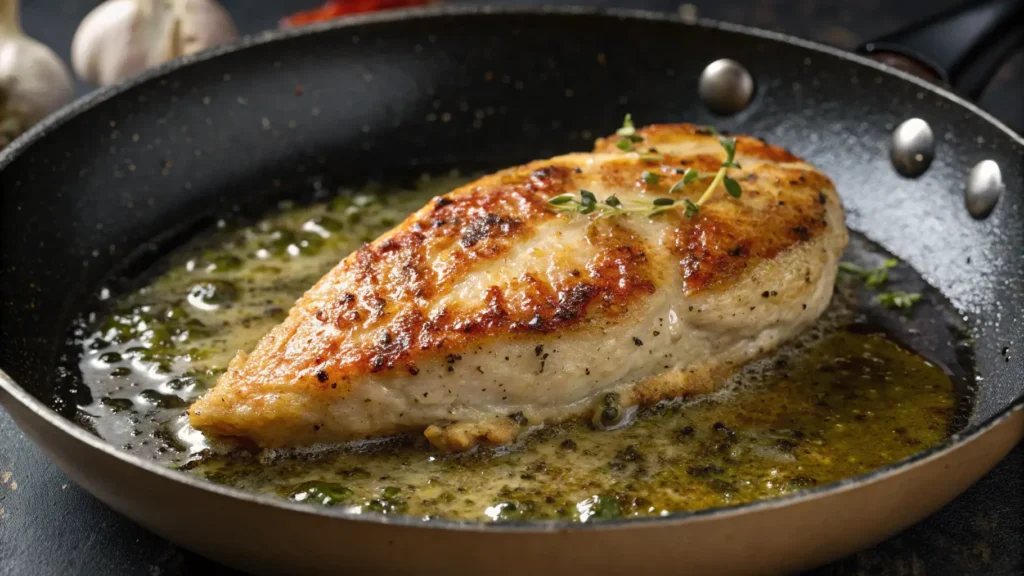
- Prep the Chicken
- Pat dry and marinate if time allows (see Part 3).
- Pound chicken evenly for consistent cooking.
- Cook the Pasta
- Bring a large pot of salted water to a boil.
- Cook fettuccine until al dente.
- Reserve ½ cup pasta water, then drain.
- Sear the Chicken
- In a large skillet, heat olive oil over medium-high.
- Add chicken and sear 4–5 minutes per side until golden and cooked through (165°F internal temp).
- Remove and let rest.
- Make the Alfredo Sauce
- In the same pan, melt butter over medium heat.
- Add minced garlic and sauté for 1 minute.
- Pour in heavy cream, simmer for 3–4 minutes.
- Reduce heat and slowly whisk in grated Parmesan.
- Season with salt and pepper to taste.
- Thin with reserved pasta water if needed.
- Combine & Serve
- Slice chicken and return to pan.
- Add pasta and toss to coat.
- Simmer for 2 minutes to let flavors meld.
- Garnish with chopped parsley and extra cheese.
Pro Tip: Always combine pasta and sauce in the skillet—never just pour sauce over pasta. This allows the starches from the pasta to bind the sauce.
How to Avoid Common Mistakes with Chicken Alfredo
Even seasoned cooks stumble here. Avoid these chicken alfredo recipe mistakes for flawless results:
- High heat curdles the cream. Always simmer gently.
- Adding cheese too quickly causes clumping. Let the cream cool slightly first.
- Pre-shredded Parmesan often contains anti-caking agents. Always use freshly grated cheese.
- Overcooked pasta won’t hold the sauce. Aim for al dente, even slightly undercooked if you’ll simmer with sauce.
- Skipping the pasta water results in a dry finish. Use it to control the sauce texture.
Cooking Timeline & Temperatures
Timing helps keep all elements hot and ready at once:
| Task | Time | Notes |
|---|---|---|
| Chicken prep & marinate | 10–30 min | Optional but recommended |
| Pasta cook time | 8–10 min | Start water early |
| Chicken cook time | 8–10 min | Sear both sides |
| Sauce prep | 10 min | After chicken is done |
| Final simmer | 2–3 min | Combine all parts |
Internal chicken temperature should hit 165°F, and sauce should never boil—keep it around 180°F max.
Add-Ons That Enhance Chicken Alfredo
What Vegetables Go with Chicken Alfredo?
Adding vegetables to your chicken alfredo recipe brings balance, color, and nutrients. Here are the best vegetable options that won’t overpower the creamy sauce:
| Vegetable | Best Cooking Method | Flavor Profile |
|---|---|---|
| Broccoli | Steamed or sautéed | Mild, slightly sweet |
| Spinach | Wilted into sauce | Earthy and soft |
| Mushrooms | Pan-sautéed | Umami-rich |
| Peas | Boiled briefly | Sweet and crisp |
| Asparagus | Blanched or roasted | Bright, grassy |
| Zucchini | Lightly sautéed | Mild and tender |
Add vegetables at the sauce stage so they absorb the flavors and don’t water down the cream. Don’t miss our rich, veggie-friendly Venison Steak Recipes for more ways to combine greens and proteins.
What Can I Add to My Alfredo to Make It Better?
Want to elevate your chicken alfredo recipe to the next level? Try these popular mix-ins and flavor enhancers:
- Crispy bacon or pancetta for smokiness
- Sun-dried tomatoes for tang and color
- Chili flakes for subtle heat
- Caramelized onions for sweetness
- Truffle oil for a gourmet edge (a little goes a long way)
- White wine splash during sauce prep for acidity and flavor depth
All these additions integrate easily into the creamy base—just add before simmering the final sauce.
Herbs, Cheeses, and Proteins That Pair Well
Herbs:
- Parsley (classic and fresh)
- Basil (sweet and aromatic)
- Thyme (earthy)
- Oregano (pungent)
Cheeses:
- Asiago (nutty and sharp)
- Romano (salty, dry)
- Fontina (melty and creamy)
- Goat cheese (tangy – adds bold contrast)
Proteins:
- Shrimp (sauté quickly in garlic butter)
- Smoked salmon (add at the end for flavor boost)
- Italian sausage (slice and sear before chicken)
- Grilled tofu (for a vegetarian twist)
Mix and match these to suit your taste—each enhances the dish in its own way. Looking for inspiration? Try our Smoked Fish Brine Recipe for bold seafood flavors that can crossover with Alfredo dishes.
Common Mistakes When Making Chicken Alfredo
Overcooking Chicken and Sauce
One of the most common reasons a chicken alfredo recipe falls flat is overcooking. Here’s what to watch out for:
- Chicken becomes dry if cooked beyond 165°F. Use a thermometer for accuracy.
- Boiling the sauce will cause it to curdle or break. Always simmer on low to medium heat.
- Leaving pasta in the pot after draining continues the cooking and can lead to mushy noodles.
Fix: Cook chicken until just done, then remove from heat. For the sauce, stir constantly and keep it below boiling. And always rinse pasta briefly in cool water if you’re not using it immediately.
Why Your Sauce Might Break or Curdle
A broken Alfredo sauce is frustrating. It often looks grainy, oily, or separated. Here’s why it happens—and how to fix it:
| Cause | Fix |
|---|---|
| Added cheese too quickly | Let sauce cool slightly before adding |
| Boiled the cream | Keep heat medium-low |
| Used pre-shredded cheese | Always use freshly grated Parmesan |
| No pasta water added | Use a few tablespoons to rebind the sauce |
Once sauce breaks, whisking in more cream gently may help recover it. But prevention is always best.
Mistakes with Pasta Texture and Timing
Perfect pasta is the foundation of any great chicken alfredo recipe. These are the top pasta missteps:
- Overcooking pasta until soft ruins texture
- Not salting water leaves pasta bland, no matter how good the sauce is
- Adding oil to boiling water prevents sauce from clinging to noodles
Best Practices:
- Salt your water heavily (it should taste like the sea)
- Cook fettuccine just to al dente
- Reserve a scoop of pasta water before draining
- Toss pasta immediately with sauce to lock in flavor
These tiny changes drastically improve your dish’s final texture and taste.
Serving and Presentation Ideas
Plating Chicken Alfredo Like a Pro
You’ve cooked the perfect chicken alfredo recipe, now it’s time to serve it with style. Presentation can elevate a simple pasta dish to restaurant status. Follow these plating tips:
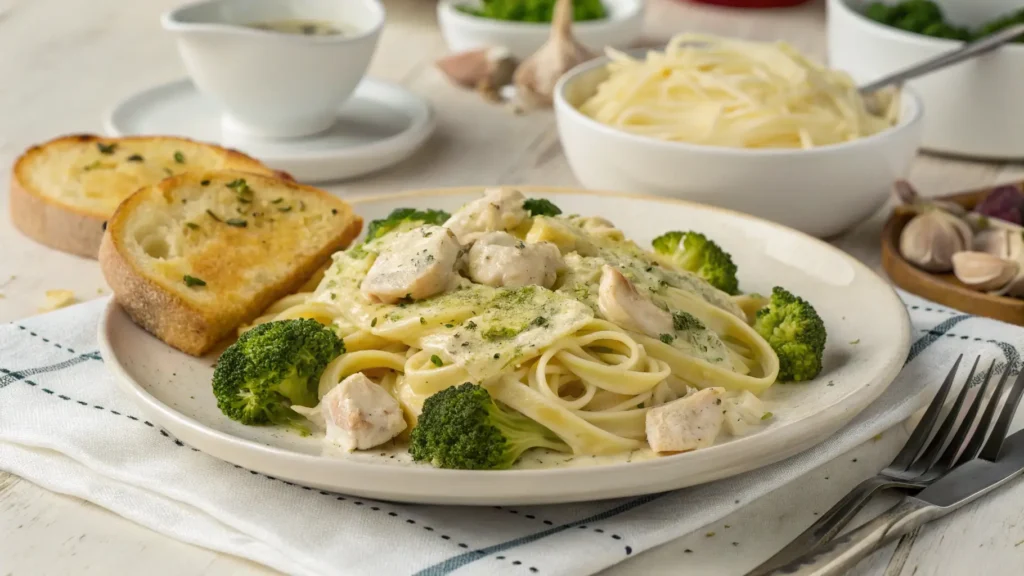
- Use wide, shallow bowls or white plates to let the cream sauce stand out.
- Toss the pasta in sauce before plating for even coating.
- Slice chicken diagonally and fan it across the top for a clean look.
- Drizzle extra sauce lightly over the chicken, not the plate.
- Finish with a sprinkle of Parmesan, cracked pepper, and fresh parsley for color contrast.
Want to serve this at a family dinner or date night? Add a lit candle and crusty garlic bread to impress without fuss.
Ideal Sides and Bread Pairings
To balance out the richness of chicken alfredo, serve sides that offer contrast in texture and flavor. Here are some top pairings:
| Side Dish | Why It Works |
|---|---|
| Caesar salad | Crunchy, tangy, fresh |
| Garlic bread | Crispy and savory |
| Steamed green beans | Light and clean |
| Roasted Brussels sprouts | Earthy and caramelized |
| Caprese salad | Fresh and acidic |
Drinks that pair beautifully:
- Chardonnay or Pinot Grigio (white wine)
- Sparkling water with lemon
- Iced tea with herbs like basil or mint
Storage and Reheating Without Drying It Out
Chicken Alfredo is best fresh, but leftovers can still shine with the right techniques:
Storage:
- Let cool completely before refrigerating.
- Store in airtight containers for up to 3 days.
Reheating Tips:
- Add 1–2 tablespoons of milk or cream before reheating.
- Use a nonstick pan over low heat and stir frequently.
- Microwave in short bursts (30–45 seconds), stirring between intervals.
Avoid freezing—cream sauces often separate when thawed and become grainy.
Don’t miss our comforting Slow Cooker Cube Steak Recipe—another meal perfect for prepping ahead and enjoying later.
Conclusion: Bring Restaurant-Quality Chicken Alfredo to Your Kitchen
This chicken alfredo recipe proves that creamy, flavorful pasta doesn’t need to be complicated. With fresh ingredients, smart timing, and a few pro tips, you can create a dish that’s rich enough for a special occasion yet simple enough for a weeknight dinner.
Whether you’re serving it up with garlic bread and wine or tossing in some spinach and sun-dried tomatoes, this dish is a blank canvas for creativity. Looking for inspiration? Try our Slow Cooker Cube Steak Recipe for more creamy comfort food favorites.
Now that you’ve mastered it—go ahead and impress your guests (or just yourself). You’ve earned it.
FAQs About Chicken Alfredo Recipe
What Are the Ingredients for Chicken Alfredo?
The core ingredients in a classic chicken alfredo recipe include:
Boneless, skinless chicken breasts
Fettuccine pasta
Heavy cream
Butter
Garlic
Grated Parmesan cheese
Salt and pepper
Olive oil
Optional add-ins include parsley, mushrooms, peas, or mozzarella for extra creaminess.
What Makes Chicken Alfredo Taste Better?
To enhance the flavor of your Alfredo dish:
Use freshly grated Parmesan instead of packaged
Add a dash of nutmeg or garlic powder to the sauce
Include chicken pan drippings for deeper flavor
Finish with a splash of lemon juice or white wine for brightness
Add herbs like parsley, basil, or thyme
These touches elevate the dish and make the sauce pop.
What Is the Secret to a Good Alfredo Sauce?
The secret lies in balance and patience:
Use heavy cream, not milk
Stir in cheese off the heat to prevent clumping
Simmer sauce gently—never boil
Add reserved pasta water to thin and bind the sauce naturally
Use real Parmesan cheese for authentic flavor
These techniques ensure a smooth, velvety finish every time.
What Are the Common Mistakes When Making Chicken Alfredo?
Top mistakes include:
Overcooking the chicken (dry and rubbery)
Boiling the sauce (it will separate)
Using pre-shredded cheese (won’t melt smoothly)
Skipping the pasta water (sauce won’t cling well)
Adding oil to boiling water (pasta won’t absorb sauce)
Avoiding these keeps your Alfredo creamy, flavorful, and cohesive.
What Are the Basic Ingredients for Alfredo?
The foundational Alfredo sauce includes:
Butter
Parmesan cheese
Pasta water
The American version also adds:
Heavy cream
Garlic
Salt and pepper
This combination creates the thick, rich sauce we’re used to in the The foundational Alfredo sauce includes:
Butter
Parmesan cheese
Pasta water
The American version also adds:
Heavy cream
Garlic
Salt and pepper
This combination creates the thick, rich sauce we’re used to in the The foundational Alfredo sauce includes:
Butter
Parmesan cheese
Pasta water
The American version also adds:
Heavy cream
Garlic
Salt and pepper
This combination creates the thick, rich sauce we’re used to in the u.s.
What to Cook First When Making Chicken Alfredo?
Follow this efficient order:
Boil water for pasta
Sear and cook the chicken
Prepare the Alfredo sauce
Cook pasta while sauce simmers
Combine everything in the skillet for final blending
This keeps all elements hot, fresh, and perfectly cooked.
What to Marinate Chicken in for Alfredo?
A quick marinade enhances flavor:
Olive oil
Lemon juice
Garlic
Salt and pepper
Optional: Italian herbs or paprika
Let it sit for 30 minutes to overnight. Even 10 minutes can improve the taste.
What Can I Add to My Alfredo to Make It Better?
these tasty upgrades:
Crispy bacon or pancetta
Caramelized onions
Sun-dried tomatoes
Red pepper flakes
Cream cheese or mozzarella
White wine or truffle oil
Mix them into the sauce for a bolder, more personalized flavor.
What Vegetables Go with Chicken Alfredo?
Top vegetable add-ins include:
Steamed broccoli
Wilted spinach
Sautéed mushrooms
Blanched asparagus
Sweet peas
Roasted zucchini
These veggies balance the richness of Alfredo and add texture and color.
Can I Use Mozzarella Instead of Parmesan in Alfredo Sauce?
You can, but it’s not ideal:
Mozzarella melts differently and can make the sauce stringy
It lacks the sharp, nutty flavor of Parmesan
If substituting, blend with cream cheese or Fontina for better consistency
For authentic taste and texture, fresh Parmesan is best.
Have you given our recipe a try?
There are no reviews yet. Be the first one to write one.

